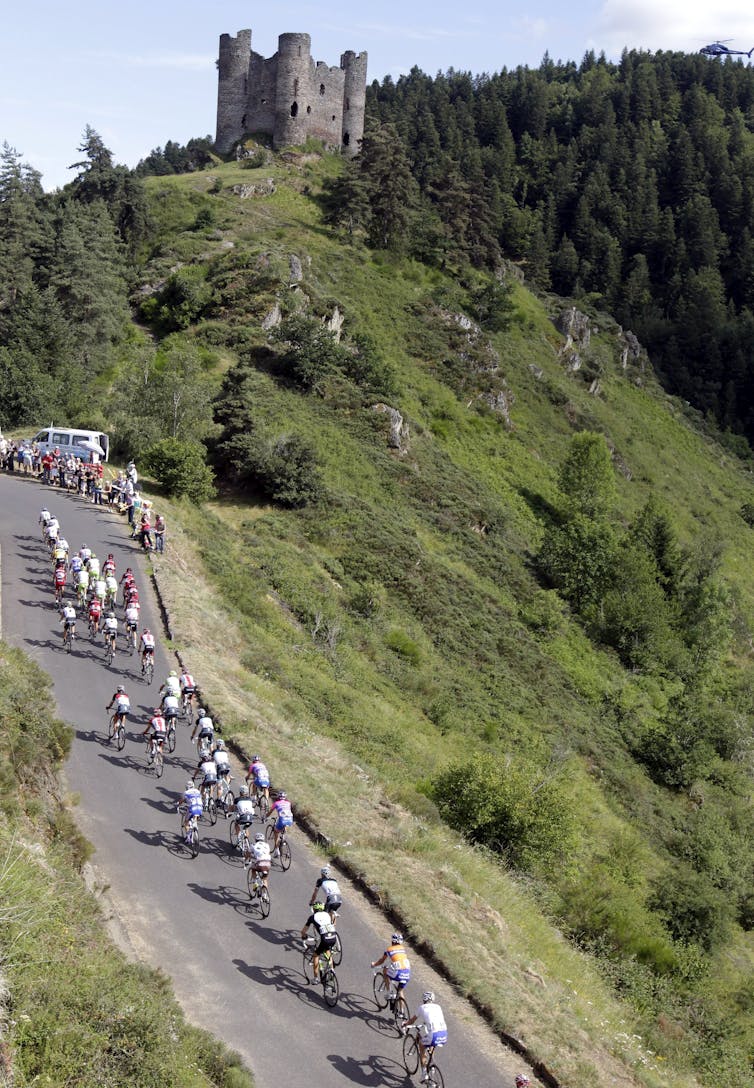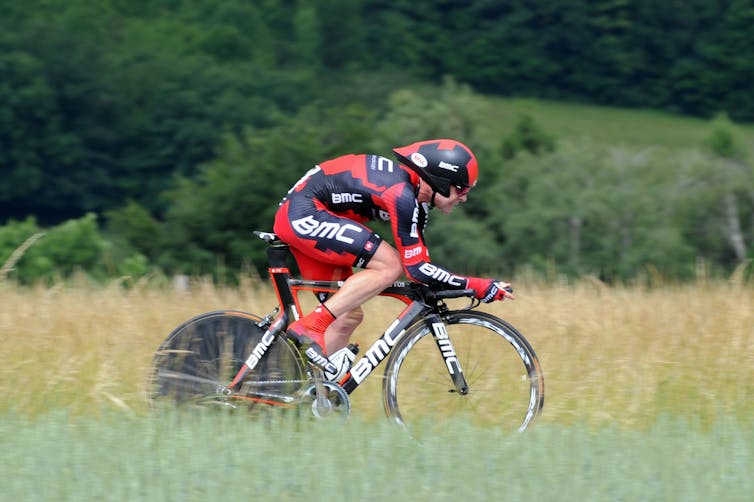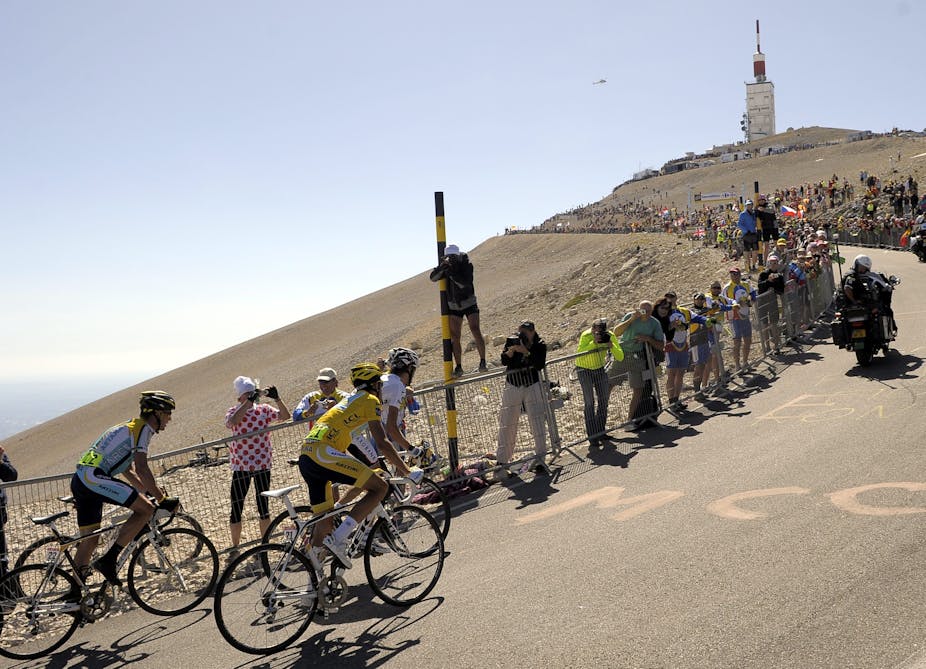This is the second in a two-part series about the science of Le Tour de France. Part one is here.
After 1,916 kilometres of the 2011 Tour de France we’re starting to see some of the favourites make their way to the top of the standings.
The first 11 stages of the race have been marred by a number of horrible crashes, forcing riders such as Alexandre Vinokourov and Jurgen Van den Broeck to abandon the race.
The reigning champion and favourite for the overall classification, Alberto Contador, is four minutes behind leader Thomas Voeckler and appears to be struggling with a knee injury.
But other favourites for the yellow jersey – including Andy Schleck, Ivan Basso and Australia’s Cadel Evans – have all stayed out of trouble and look to be well placed for the second half of the race.
Onward and upward
The first half of the race was dominated by flat stages and a few short climbs, but the second half is all about the mountains. In fact, the final ten stages of the race will see riders venture into both the Pyrenees and the Alps, competing in a total of six high mountain stages.
While the flat stages are all about avoiding wind resistance, the greatest force opposing riders in the high mountain stages (tonight’s stage included) is gravity.
Gravity is a downward-orientated force that is proportional to the mass of the object in question – in this case, the cyclist plus their bike.
As a result, heavier riders will have to apply a greater force and produce more power (measured in watts) than lighter riders during the climbs.
(Unfortunately for them, the advantage they will get during the descents will not be as important.)
On the slopes, the best climbers will produce more than six watts per kilogram of body mass – 420 watts for a climber of 70 kilograms. To put this into some kind of context, an average recreational rider can produce around 200 watts while climbing at reasonable intensity.

From a physiological point of view, the best climbers will maintain effort intensities close to 90% of their maximum aerobic capacity while climbing.
Maximum aerobic capacity (also known as VO2max) is the maximum amount of oxygen an athlete can utilise at a given moment and it can be expressed in mLO2/kg/min (number of millilitres of oxygen per kilogram of body weight, per minute).
Climbing specialists such as Andy Schleck and Alberto Contador can take in 80 mL/min/kg compared with 40 mLO2/min/kg for sedentary adults.
(Don’t) follow the leader
During the high mountain stages, the favourites for the yellow jersey will ask their teammates to lead the peloton. These teammates – known as domestiques – will ride at a speed that is designed to force other yellow-jersey-contenders into the “red zone”.
A rider’s “red zone” starts at his “lactate threshold” – the exercise intensity above which lactic acid starts to accumulate in the muscles, creating a burning sensation and, ultimately, fatigue.
If the pace set by riders at the front of the peloton is not high enough, riders fighting for the yellow or polka dot jerseys (for the overall leader and best climber respectively) or even for the stage win, might break away.
To breakaway, such riders will adopt a standing posture on their pedals so they can use the mass of their body as an additional force on the pedals.
During these key moments of the race, the power produced by an attacking rider will reach around nine watts per kilogram – far beyond the reach of any recreational cyclist. Efforts of this kind will put riders beyond their lactate threshold, causing a rapid accumulation of lactic acid in their muscles.
As a result, riders can’t indefinitely maintain or repeat these breakaway efforts and instead have to be very strategic about when they produce them.
Bonking
The more power a rider generates, the quicker his metabolic reserves are depleted. For riders that are constantly riding at a high intensity, there’s often little opportunity to eat or drink and energy reserves can easily be depleted.
On a high mountain stage of Le Tour, a rider can expend as much as 25,000 kilojoules (~6,000 calories) – roughly three times the recommended daily energy intake for a sedentary adult.
If riders forget to replenish their energy reserves while climbing, they will reach a point where they simply run out of energy and are no longer able to push on the pedals. This is known as “hitting the wall” or “bonking”.
Our time is running out
After the big battles that are sure to happen in the Pyreness and the Alps, riders will have a rest day before one final fight in the Grenoble individual time trial.
In an individual time trial, each rider races against the clock and the rider with the lowest time wins the stage.
In a time trial, it’s crucial for riders to constantly adjust their gearing in order to maintain an optimal cadence (frequency of pedal stroke) of between 90 and 100 revolutions per minute.
For this stage, the power generated by the riders will be just below their lactate threshold (more than 400 watts). Riders that can maintain high levels of power throughout the 42.5 kilometre stage will be well placed for a high finish.
As with the earlier, flatter stages of the Tour, the individual time trial will require riders to minimise the air resistance they experience. They will do this by using the most advanced equipment (e.g. bike frame, wheels, and helmet) and maintaining a riding position that will reduce their “frontal area” as much as possible.

Following the individual time trial, it will be time for one final stage: the traditionally-slow ride into Paris followed by a bunch sprint on the famous Champs Elysees.
By this point, the overall winner of Le Tour will be decided, as will the polka dot jersey competition and white jersey (best young rider) competition. For the powerful sprinters – riders such as Mark Cavendish, José Joaquín Rojas and Thor Hushovd – the final sprint on the Champs Elysees will allow one final chance of glory.
Ultimately though, the greatest accolades will be reserved for the winner of the overall classification, the maillot jaune. And who will that be?
Well, you’ll just have to watch to find out.
This is the second in a two-part series about the science of Le Tour de France. Part one is here.

